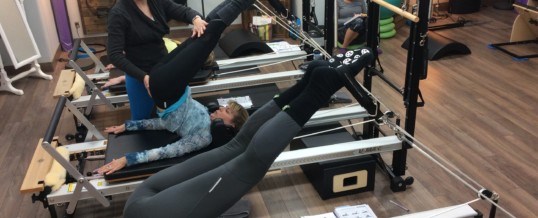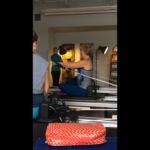
Weekend 6 zooms and flows by…….
Even though I’m never sure what more I can write about, I still ALWAYS learn something new. I also learn some things again (or maybe they just sink in better?) Such a layering process, this Pilates education.
Because of our increasing proficiency, we can now handle a faster pace of learning and take quicker turns practicing the repertoire exercises. We zoom through the higher-level difficulty exercises in our apparatus manuals, after Tanis reviews some key principles with us in simple standing warm ups. Our note-taking is always mixed in with movement so although we know we’ll feel tired and sore by the end of the weekend, it will be that good and balanced kind, not the dreaded overuse feeling. Bodies really do like Pilates.
Footwork is still and always a key theme in EVERYTHING so we return to the sometimes-painful but never-boring Foot Corrector. Observing from every angle, we clearly see how this miracle worker can uncover and actually correct basic issues in each other’s bodies. And in the process, discover happier, stronger feet as well as (shhh!) the secret of the pinky toe!
Then we return to the Reformer and other apparatus to continue re-working the body’s weaknesses and build strength. There are some memorable names/nicknames for the level two exercises like Hug a Tree and Elephant but as a hiker, I think I’m going to love Mountain Climber the most. I am thoroughly humbled.
NO babying for us now! We need to work towards our goals of better functionality and sometimes that means breaking down the barriers—conscious or unconscious—and our levels of comfort. When one of us remarks how we prefer the cross-legged position in one exercise, Tanis pounces: “What our bodies prefer to do is not necessarily good for us – so we have to challenge it.” Be not afraid to get people to work harder, she continues, and don’t modify before getting them working in their own body!
While watching others, we are reminded that we can now find that which we know in our own bodies. (I think this also means since we are so intimately familiar with the many ways to cheat, we can recognize it in others. Busted!) A lightbulb moment comes courtesy of one of our more “internally twisted” TTs who falls for an optical illusion. We see how our own (and other bodies) can sometimes fool us, when Tanis shows us how to look beyond the potentially unevenly or overdeveloped muscles to see where the bones are aligned. Might she be slightly twisted because of muscular scoliosis? Naturally we joke that we are all a little twisted, but Pilates IS about the untwisting. We have to untrain our bodies before we can retrain them to work differently and more functionally.
However, even if the goal is straight and solid, the priorities remain core stability and alignment. The standing exercises that we are tackling this weekend naturally test our core strength more. We have to pay more attention to both our alignment in space and on the apparatus. As instructed, we try not to fall into our joints, but work the correct muscles.
We’re really feeling our upper bodies this weekend — those rarely worked muscles like the serratus and lats that are so critical for stability. Some moaning is heard about how our unwinding bodies have uncovered aches and adjustments in previously compensating parts. But after lunch, we are raring to go again.
In all our exercises, we are scooping better (and I don’t mean ice cream) and, as we put a couple of component exercises together, we also start to get the concept of flow in the elegant Swan.
One of the biggest differences in Pilates training vs other exercise methodologies is the attention paid to the individual body and ensuring appropriate movement patterns. Don’t be afraid to be a broken record with your cues, says Tanis, as she tells us: “pull in those ribs, ensure even pressure on the feet, massage that colon (!), grow a tail (?), etc. etc.” Or whatever is needed, modifying cues to the individual, as Tanis does for each of us.
And then the subtlety of the breath, so important a concept in Pilates, comes up again. We stop to discuss inhalation and exhalation patterns when instead of flexing our spines in an exercise, some of us experience jamming, which is neither effective nor efficient. Pilates breathing, compared to that of weightlifting and other exercise types, is different for good reasons, Tanis starts to explain, but then our weekend is at an end. To be continued …
Postscript: A special treat in the week following are one-on-one sessions with Tanis, who teaches only teachers now. We take advantage to work on the deeper levels of our own compensatory issues, to consolidate what we learned that weekend and/or to consult on particularly challenging student issues. Time well spent to grow our education yet another level.



